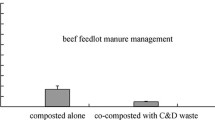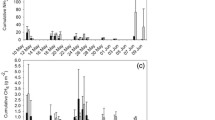Abstract
Emission measurements from dairy cows housed in a tying stall were carried out with the aim of finding factors that influence the amount of emissions and means to reduce emissions. All sectors of animal husbandry were investigated. This enabled calculations of emissions for the whole management system including housing, storage and spreading of manure. Emissions during aerobic composting and anaerobic stacking of farmyard manure were compared. NH3 and N2O emissions from tying stalls for dairy cows are low (5.8 g NH3 LU−1 d−1, 619.2 mg N2O LU−1 d−1). Methane emissions from the animal housing are mainly caused by enteric fermentation. During storage and after spreading of farmyard manure substantial differences concerning NH3, N2O and CH4 emissions were observed with composted and anaerobically stacked farmyard manure. The compost emitted more NH3 than the anaerobically stacked farmyard manure. About one third of the NH3 emissions from the anaerobically stacked farmyard manure occurred after spreading. Total N losses were at a low level with both storage systems. Greenhouse gas emissions (N2O and CH4) were much higher from the anaerobically stacked farmyard manure than from the composted one. As these are ecologically harmful gases, they have to be considered when judging the form of manure treatment.
Similar content being viewed by others
References
Ambus P & Christensen S (1995) Spatial and seasonal nitrous oxide and methane fluxes in Danish forest-, grassland-and agroecosystem. J Environ Qual 24: 993–1001
Amon B, Amon T, Boxberger J, Pöllinger A & Zaussinger A (1996) Entwicklung einer Meβeinrichtung zur Erfassung umweltrelevanter Gasemissionen. Die Bodenkultur 47(7): 247–253
BUWAL Schweiz (1995) Handbuch Emissionsfaktoren für stationäre Quellen.
Denmead O, Freney L & Simpson J (1982) Dynamics of ammonia voltatilization during furrow irrigation of maize. Soil Sci Soc Am J 46
Dewes T (1996) Biotisch und abiotisch bedingte NH3-Emissionen während der Lagerung von Stallmist. Agribiol Res 49(2–3): 203–210
Duxbury J (1994) The significance of agricultural sources of greenhouse gases. Fert Res 38: 151–63
Gibbs M & Woodbury J (1993) Methane emissions from livestock manure. International Workshop Methane and Nitrous Oxide, Amersfoort
Groenestein C & Montsma H (1991) Field research into the ammonia emission from animal housing systems: Tying stall for dairy cattle. Report 91–1002, DLO, Wageningen
Gruber L, Steinwidder A, Stefanon B & Steinwender R (1998) Influence of grassland management and concentrate level on N excretion of dairy cows. International conference “Agriculture and environment”, Bled Slovenia, 18–23 March, pp 433–441
Günzler H & Böck H (1983) IR-Spektroskopie: Eine Einführung, zweite Auflage. Verlag Chemie GmbH, Weinheim
Hümbelin M, Meyer M & Sticher H (1980) Stickstofffixierung bei der Kompostierung von Rindermist. Schweiz Landw Forschung 19(1–2): 85–90
Husted S (1993) An open chamber technique for determination of methane emission from stored livestock manure. Atmos Environ 27a(11): 1635–1642
Hüther L (1999) Entwicklung analytischer Methoden und Untersuchung von Einfluβfaktoren auf Ammoniak-, Methan-und Distickstoffmonoxidemissionen aus Flüssig-und Festmist. Landbauforschung Völkenrode, Sonderheft 200
IPCC (1997) Revised 1996 IPCC Guidelines for national greenhouse gas inventories. OECD/OCDE, Paris
Isermann K (1994) Ammoniak-Emission aus der Landwirtschaft, ihre Auswirkungen auf die Umwelt und ursachenorientierte Lösungsansätze sowie Lösungsaussichten zur hinreichenden Minderung. In: Studienprogramm Landwirtschaft, Enquête-Kommission Schutz der Erdatmosphäre des Deutschen Bundestages, pp 1–250, Band 1. Landwirtschaft. Teilband I. Economia Verlag GmbH, Bonn
Jarvis S & Pain B (1994) Greenhouse gas emissions from intensive livestock system: their estimation and technologies for reduction. Climatic Changes 27: 27–38
Kaiser E, Eiland F, Germon J, Heinemeyer O, Henault C, Lind A, Maag M & Saguer E (1996) What predicts nitrous oxide emissions and denitrification-loss from European soils? Z Pflanzenernähr Bodenk 159: 541–547
Kinsmann R, Sauer F, Jackson H & Wolynetz M (1995) Methane and carbon dioxide from dairy cows in full lactation monitored over a six-month period. J Dairy Sci 78: 2760–2766
Kirchgessner M, Windisch W, Müller H & Kreuzer M (1991) Release of methane and of carbon dioxide by dairy cattle. Agribiol Res 44: 91–102
Kirchmann H & Lundvall A (1998) Treatment of solid animal manures: identification of low NH3 emission practices. Nutr Cycl Agroecosyst 51: 65–75
Konrad S (1994) Erhebungen zur Tierhaltung in Österreich. Forschungsprojekt L 499/87. Bundesministerium für Land-und Forstwirtschaft, Wien
Menzi H, Katz P, Frick R, Fahrni M & Keller M (1997) Ammonia emissions following the application of solid manure to grassland. In: Jarvis S & Pain B (eds) Gaseous Nitrogen Emissions from Grasslands, pp 265–274. Oxon, UK: CAB International
Meyer M (1982) Stickstoffumsatz bei der Kompostierung von Rinderfestmist. Dissertation ETH Zürich No. 7180
Monteny G & Kant P (1997) Ammonia emission and possibilities for its reduction in dairy cow houses: a review of Dutch developments. In: Voermans JAM & Monteny GJ (eds) Ammonia and Odour Control from Animal Production Facilities, EurAgAng, pp 355–364. International Symposium, 6–10 October 1997, Vinkeloord, The Netherlands
Mosier A (1989) Chamber and isotope techniques. In: Andreae M & Schimel D (eds) Exchange of Trace Gases between Terrestrial Ecosystems and the Atmosphere, pp 175–187. Dahlem Konferenzen
Mosier A (1994) Nitrous oxide emissions from agricultural soils. Fert Res 37: 191–200
Oldenburg J (1989) Geruchs-und Ammoniak-Emissionen aus der Tierhaltung. KTBL-Schrift 333, Kuratorium für Landtechnik und Bauwesen in der Landwirtschaft e.V., Darmstadt
Pain B (1998) Gaseous pollutants from organic waste use in agriculture. In: Martinez J & Maudet M-N (eds) RAMIRAN 98, 8th International Conference on Management Strategies for Organic Waste Use in Agriculture, pp 233–246
Römer G, Boeker P & Schulze-Lammers P (1994) Ammoniakemissionen von Festmist. Landtechnik 49(2): 72–73
Schütz H & Seiler W (1989) Methane flux measurements: Methods and results. In: Andreae M & Schimel D (eds) Exchange of Trace Gases between Terrestrial Ecosystems and the Atmosphere, pp 209–228. Dahlem Workshop Report
Sneath RW, Phillips VR, Demmers TGM, Burgess LR, Short JL & Welch SK (1997) Long-term measurements of greenhouse gas emissions from UK livestock buildings. Proceedings of the fifth international livestock environment symposium, Minneapolis-St Paul, Minnesota, 29–31 May, ASAE, pp 146–153
Staab J (1991) Industrielle Gasanalyse. Technisches Messen 58(1): 29–35
Velthof G, Jarvis S, Stein A, Allen A & Oenema O (1996) Spatial variability of nitrous oxide fluxes in mown and grased grasslands on a poorly drained clay soil. Soil Biol Biochem 28(9): 1215–1225
Author information
Authors and Affiliations
Rights and permissions
About this article
Cite this article
Amon, B., Amon, T., Boxberger, J. et al. Emissions of NH3, N2O and CH4 from dairy cows housed in a farmyard manure tying stall (housing, manure storage, manure spreading). Nutrient Cycling in Agroecosystems 60, 103–113 (2001). https://doi.org/10.1023/A:1012649028772
Issue Date:
DOI: https://doi.org/10.1023/A:1012649028772




